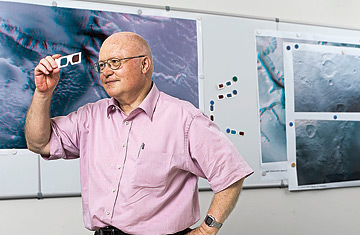
Professor Dr. Gerhard Neukum, the developer of the High Resolution Stereo Camera.
The odds are not very good that you'll ever go hiking on Mars, but if you do, it'll probably be Gerhard Neukum who provides you with your maps. Neukum, 63, has never been in space, but his cameras have, and thanks to them, earthbound scientists are getting as clear a view of other worlds as any astronaut could hope to see.
Neukum, a professor of planetary sciences at the Free University of Berlin, was drawn to the cosmos in the 1970s when, as a physics student at the University of Heidelberg, he landed a plum spot conducting research for NASA's Apollo lunar program. He was enchanted as he contemplated photos of the moon, but he was also frustrated. "I didn't just want to analyze data but send my own camera up there, one that would produce better data than all previous cameras," he says. He eventually invented just such a thing, a stereoscopic imager that earned a spot aboard a 1996 Russian Mars probe. But that probe fell a wee bit short of Mars, crashing into the Pacific Ocean after orbiting Earth twice. "On the plane back to Moscow," Neukum recalls, "I thought to myself, This can't be the end."
It wasn't. In 2003 the European Space Agency launched its Mars Express spacecraft with the next iteration of Neukum's camera on board. The ship reached its target, and before long, Neukum's 3-D color images were being admired around the world. The camera's nine sensors simultaneously scan an object, each from a different perspective, then combine those images with pictures taken by a telephoto lens. The images that result are 100 times as sharp as those from the Viking Mars missions of the 1970s.
Neukum's pictures have helped reveal that as recently as a few million years agolast week in geologic timethere were active glaciers on Mars. Ultimately, he hopes to compile a sort of topographical hiking map of the entire planet. And in 2013 an enhanced version of his camera will fly again, this time on a German moon mission. For a man who does not stray far from home, Neukum produces the best travel shots you're likely to see.